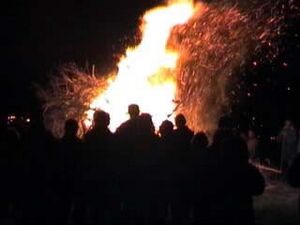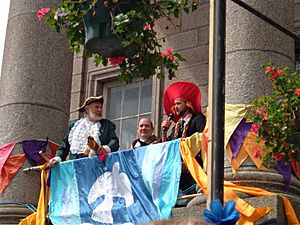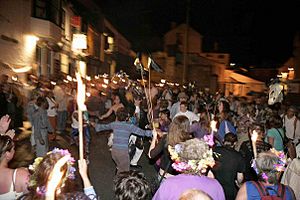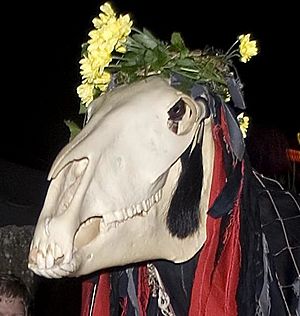Golowan Festival facts for kids
Golowan is a special word from the Cornish language. It means the celebrations held in Cornwall, UK, around Midsummer. For a long time, these celebrations were very popular, especially in areas like Penzance and Newlyn. People would light big bonfires and fireworks, and do old rituals.
The midsummer bonfire ceremonies, called Tansys Golowan in Cornish, were brought back to life in St Ives in 1929 by the Old Cornwall Society. Since then, these celebrations have spread to other parts of Cornwall.
Since 1991, the Golowan festival in Penzance has brought back many of these old customs. It has grown into a big arts and culture festival. Its main event, 'Mazey Day', now brings tens of thousands of people to Penzance in late June.
The 2021 Golowan Festival was from June 18 to 27, with Mazey Day on Saturday, June 26.
Contents
The Story of Golowan
The old festival was first written about by Dr. William Borlase in 1754. He described how people in Cornwall lit bonfires on the evenings of St. John the Baptist's Day and St. Peter's Day. Midsummer was called 'Goluan' in Cornish, meaning both light and joy.
People would gather around these fires with lighted torches. They would walk from village to village, carrying their torches. This was seen as a very old tradition, like those from ancient times.
Golowan in Penzance
The Golowan celebrations in Penzance were some of the last of their kind in Cornwall. They stopped in the 1890s because of worries about fire safety. The celebrations mainly involved lighting fireworks, tar barrels, and torches on the evening of June 23 each year (St. John's Eve).
After the fires died down, young people would do an old serpent dance. They would even jump or pass through the last glowing embers of the flames. During these parties, people would also choose a fun leader called a Mock Mayor or "Mayor of the Quay."
In 1864, it was noted that the festival committee set off "258 dozen fire crackers" and many other fireworks. The day after these celebrations, a 'Midsummer's Day' fair was held on Penzance quay, with boat rides and other fun activities.
Here are some descriptions of the fire festival from the past:
- In Penzance and other nearby villages, on the evenings of June 23 and 28, lines of tar barrels and bonfires were lit in the streets. At the same time, bonfires glowed on hills around Mounts Bay.
- Villagers would hold hands and dance around the fires. This was believed to protect them from bad luck. When the fires burned low, some people would leap through the flames for good luck. Older people would count the fires and try to guess what the future held.
The town-crier would announce that fireworks were not allowed, but everyone knew this rule would be ignored! Many people would come from the quay, swinging huge torches above their heads. These torches were made of canvas soaked in tar. They gave off a lot of heat and smoke.
St Peter's Eve Celebrations
Places like Porthleven and Newlyn especially celebrated St. Peter's-tide. This is because St. Peter is the patron saint of fishermen. St. Peter's-tide is still celebrated in Porthleven, though in a quieter way.
In 1883, the celebrations in Newlyn were delayed. This happened because most of the fishing boats were at sea. They returned and celebrated the fire festival many days later. The Mevagissey feast, which happens around St. Peter's Eve, is still celebrated today.
St Just's Traditions
The people of St Just in Penwith had their own special ways of celebrating. A history book from 1868 says:
- On Midsummer-day, people would hear sounds like gunshots. These came from holes drilled in rocks, filled with gunpowder, and then exploded.
- On the same day, every mine would fly a new flag. The night would begin with noisy parties and bonfires blazing on many hills.
Festivals Around Europe
Many other fire festivals are held across Europe on June 23 and 24. For example, there's St. John's Eve in Ireland, Jāņi in Latvia, and Saint Jonas' Festival in Lithuania. Golowan is part of this much wider European tradition of celebrating Midsummer.
Modern Golowan Celebrations
The modern Golowan Festival in Penzance began in 1991. It was started to bring back many of the old traditions. The main part of the modern festival is a long weekend that includes Mazey Eve, Mazey Day, and Quay Fair Day.
- Mazey Eve: On Thursday, people choose the 'Mayor of the Quay'. On Friday, Mazey Eve takes place around Penzance harbour with a big firework display.
- Mazey Day: The next day, Mazey Day, is a huge community and arts celebration. Schools, performers, and community groups take part in parades. These parades feature music, giant sculptures, and other artistic displays. Musicians and artists from other Celtic countries often join in. Penzance is decorated with lots of greenery, just like in the old festival. Many market stalls are also set up throughout the town. Mazey Day brings thousands of visitors and is a very important event for the town's identity.
- Quay Fair Day: This celebration is similar to the old 'Midsummer Fair'. It includes popular street entertainment.
Since 2015, a special community company has been in charge of running the festival.
Penglaz: Penzance's 'Obby 'Oss
On Mazey Eve and June 23 (St. John's Eve) each year, Penglaz, the Penzance 'Obby 'Oss, appears. Penglaz is inspired by descriptions of a hobby horse that used to go with Christmas guise dancers in Penzance in the 1800s.
One old description said the horse was "a man carrying a piece of wood shaped like a horse's head and neck." It could open and shut its mouth with a loud snap. The person was covered with a horse cloth to look like an animal.
Another writer described "Old Penglaze" as a character with a blackened face and a staff. He had a person covered in a horse's hide to be his horse. This horse would prance and jump around in a funny way.
Barbara Spooner described the 'Obby 'Oss linked to "Old Penglaze" as "a horse's skull held up on a stick by a hide-covered or sheet-draped man." She said it had its own Cornish name, Penglas, meaning 'Grey head'.
The modern Penglaz at the Golowan festival looks like the descriptions of the "mast" type of hobby horse. It is very similar to the Mari Lwyd from Welsh tradition. Penglaz was first introduced in 1992 at the second revived Golowan festival.
Old Cornwall Society Bonfires
The old Golowan celebrations also inspired the Old Cornwall Societies' midsummer bonfire celebrations. These hilltop bonfires form a chain across Cornwall. They are currently held at places like Kit Hill, St Breock beacon, Castle An Dinas, and Redruth.






